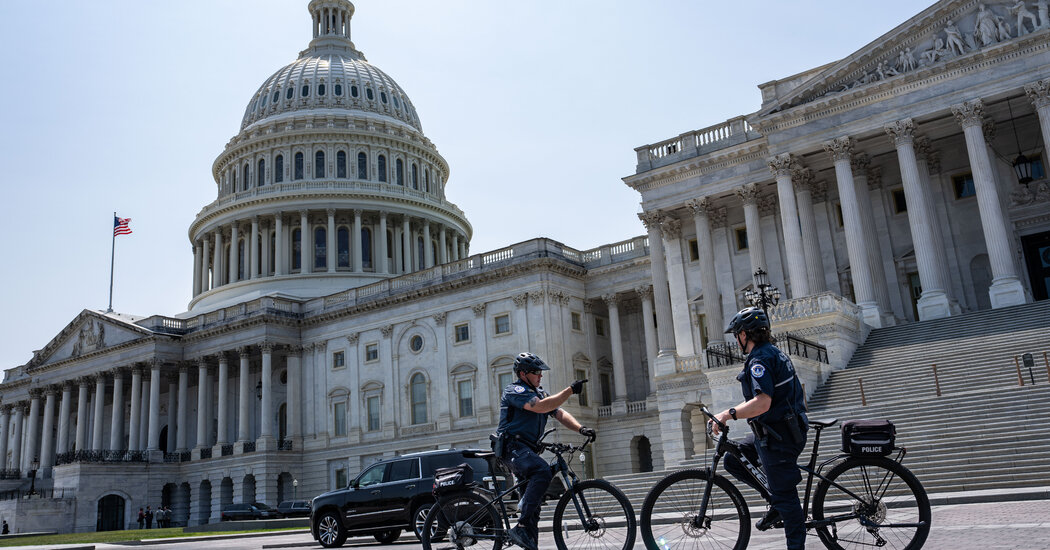The attack on two congressional aides this week at the Fairfax, Va., office of Representative Gerald E. Connolly has prompted members of Congress and their staffs to consider additional safety measures in their workplaces outside of Washington.
On Monday, two staff aides were injured and subsequently hospitalized after a bat-wielding man entered Mr. Connolly’s district office asking for the congressman and then went on a rampage. According to Mr. Connolly, one of his senior aides was hit in the head, and an intern in her first day on the job was hit in the side.
According to an affidavit, the attacker shouted, “I’m going to kill you” and “You’re going to die” as he hit one staff member, and later, a witness overheard him shouting “Gerry” and that he “wanted to talk.”
It was the latest incident of violence targeting political figures to instill fear on Capitol Hill. Aides throughout the institution were reviewing their emergency plans and discussing possible changes to office policies, including cutting down on face-to-face interactions with people who drop in to district offices.
In February, Representative Angie Craig, Democrat of Minnesota, was assaulted in an elevator at her apartment building a mile from the Capitol. Months earlier, Paul Pelosi, the husband of Representative Nancy Pelosi, Democrat of California, was hospitalized after an encounter with an intruder at their San Francisco home. The man said he was looking for Ms. Pelosi, then the House speaker, and slammed a hammer into Mr. Pelosi’s head.
The United States Capitol Police, the agency tasked with protecting the Capitol complex, reported 7,501 threats against members of Congress last year. That was roughly 2,000 fewer than in 2021, but significantly more than the 902 threats investigated in 2016.
While members and staff aides are protected in the Capitol and its surrounding office buildings by the Capitol Police, offices in their respective congressional districts around the country generally do not receive such protection unless there is a specific known threat to the lawmaker.
“Many of us like to think of our district offices as being a place where we welcome our constituents,” said Representative Pramila Jayapal, Democrat of Washington, who was verbally harassed by a man wielding a semiautomatic handgun in front of her Seattle home last year. “I don’t think that we have, as a body, really given the attention to district offices that we should.”
After the attack on Mr. Connolly’s office, Jaime Lennon, the communications director for Representative C.A. Dutch Ruppersberger, Democrat of Maryland, said her team was discussing changes.
“We decided that for walk-ins — that would be constituents who haven’t made a prior appointment with us — we’re just going to try our best to conduct business through the intercom as much as possible, unless we have an established relationship with the constituent,” Ms. Lennon said.
Representative Dan Kildee, Democrat of Michigan, said his chief of staff, Mitchell Rivard, had reached out to the House Chiefs of Staff Association to urge top aides to discuss safety practices with their district offices.
“We’re going to do what we can in order to minimize the risks that they face,” Mr. Kildee said.
Since 2017, members of Congress have been allowed to request additional security measures for district offices from the sergeant-at-arms, the chamber’s top law enforcement officer, at no cost, according to a senior Republican aide who insisted on anonymity to discuss security issues. The House sergeant-at-arms has covered the cost of installation and monthly fees for security systems in district offices, including features such as intercoms, motion sensors, cameras, panic buttons, and glass-breaking detection, the aide said.
The sergeant-at-arms can also conduct safety assessments for district offices, at the request of lawmakers. In addition, the office has been looking to increase its contracts with local police departments to provide additional security for members when they return to their home districts.
Members can also use funding set aside by Congress for office operating expenses for security purposes. Many have also dipped into their campaign funds in order to finance such measures. According to a New York Times analysis, members of Congress spent more than $6 million on security from January 2021 to September 2022.
In addition, amid lawmakers’ calls for additional safety measures, the House sergeant-at-arms created a program in July 2022 that provided $10,000 for members to secure their residences. The Capitol Police also hired a new intelligence director to improve data collection and sharing, has provided security assessments on members’ homes and district offices, and opened two field offices in Florida and California.
Still, the force has struggled with the influx of threats amid severe strains on the department even as funding for the agency has grown in recent years.
“Even with our recent staffing increases, we remain significantly understaffed for an agency that has nationwide jurisdiction and responsibilities, and a growing mission and increasing workload,” J. Thomas Manger, the Capitol Police chief, testified at a Senate Appropriations subcommittee hearing last month.
Mark Bednar, a spokesman for Speaker Kevin McCarthy, Republican of California, said in a statement that the speaker had directed the top Capitol law enforcement officials to remind members of the resources available to them following the incident.
Still, lawmakers have been shaken by the latest attack.
Representative Becca Balint, a first-term Democrat from Vermont, said she was in the process of opening up a satellite office in her home state and that the incident at Mr. Connolly’s office made her wonder if hers was protected enough.
“We certainly don’t sign up to get beat up or to be attacked, but we do sign up to be in the public eye, and our staffers are just trying to support us,” Ms. Balint said.

